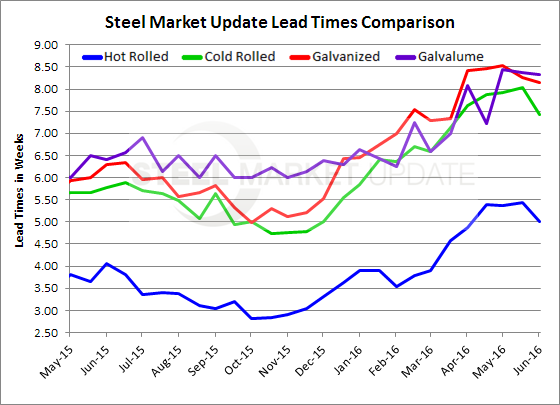SMU Data and Models

Steel Mill Lead Times: Past Peak?
Written by John Packard
June 19, 2016
Steel mill lead times, the amount of time it takes to get steel produced from the time a flat rolled steel order is placed, have apparently peaked and we are beginning to see signs of a slight pull back in all but coated products. Having said that, lead times still continue to be highly extended compared to one year ago.
Hot rolled lead times, which one year ago averaged 4 weeks (4.06) are now averaging 5.00 weeks according to the most recent results produced by our flat rolled steel market trends analysis this past week. The 5 weeks is two weeks longer than what we were reporting back in October and November 2015.
Cold rolled lead times average 7.5 weeks this past week. This is down from 8.0 weeks reported at the beginning of June. However, one year ago cold rolled lead times were averaging less than 6 weeks (5.78). At the low point back in early 4th Quarter 2015, CR lead times were under 5 weeks.
The lead times on galvanized steel continue to be extended averaging slightly more than 8 weeks (8.15) well above the 6.29 weeks reported on year ago. At the low point during the 4th Quarter of 2015 GI lead times were at, or just above, 5 weeks.
Galvalume lead times continue to be above 8 weeks (8.33) where they have been since the middle of May 2016. One year ago AZ lead times were just shy 6.5 weeks (6.40) and at the low point in were averaging 6.0 weeks.
Lead times are a good measure of the strength of the domestic steel mill order books. The longer the lead time the stronger the book of business at the mills. The stronger the book the less negotiating the steel mills have to do to get customers to place orders.
A side note: The data for both lead times and negotiations comes from only service center and manufacturer respondents. We do not include commentary from the steel mills, trading companies, or toll processors in this particular group of questions.
To see an interactive history of our Steel Mill Negotiations data, visit our website here.

John Packard
Read more from John PackardLatest in SMU Data and Models

SMU’s June at a glance
A look at SMU data for the month of June.

SMU Survey: Buyers’ Sentiment rebounds from multi-year low
Both of SMU’s Steel Buyers’ Sentiment Indices edged higher this week. Current Sentiment rebounded from a near five-year low, while Future Sentiment rose to a two-month high

SMU flat-rolled market survey results now available
SMU’s latest steel buyers market survey results are now available on our website to all premium members.

SMU Survey: Sheet lead times pull back after early-June blip, plate holds
Following the uptick seen two weeks ago, lead times eased this week for all four sheet products tracked by SMU, while plate lead times held steady, according to this week’s market survey.

SMU Survey: Pricing power abruptly shifts to steel buyers
The majority of steel buyers responding to our latest market survey say domestic mills are more willing to talk price on sheet and plate products than they were earlier this month. Sheet negotiation rates rebounded across the board compared to early June, while our plate negotiation rate hit a full 100%.

